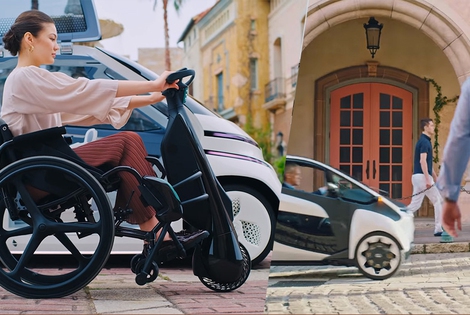
Milan has announced one of Europe’s most ambitious mobility schemes, known as Strade Aperte (open roads). Its goal is to reduce cars in phase 2 of the lockdown by increasing bike lanes and pedestrian areas.
Bosch and TomTom believe that the maps incorporated in cars GPS systems must have a margin of error of a decimetre, in order to make self-driving possible in the near future. By the end of 2015, the two companies will completely computerise all Germany highways. To turn self-driving car to reality (and this will be painful for
Bosch and TomTom believe that the maps incorporated in cars GPS systems must have a margin of error of a decimetre, in order to make self-driving possible in the near future. By the end of 2015, the two companies will completely computerise all Germany highways.
To turn self-driving car to reality (and this will be painful for cars lovers or for people who loves driving), huge road works are needed , to make “communication” possible between roads and road signs and cars, through a set of sensors and cameras.
Thanks to an agreement aiming to support self-driving, TomTom will draw the map of Germany, while Bosch, on the basis of an engineering development study, will define the requirements to be met by the maps. Tests are currently carried out on some highways in Germany (A81) and in the United States (I280).
Dirk Hoheseil, a Bosch General Manager and Jan Maarten de Vries, TomTom Vice President, share the same point of view: “We will only be able to have self-driving vehicles on the highway in 2020 with highly accurate maps. We want to have highly accurate maps for self-driving vehicles of all highways and similar roads in Germany by the end of 2015”. The next step will be mapping the road network in Europe and North America.
Someone says our cars’ GPS systems already feature the most accurate maps of all Europe, which is true but it is not enough. Self-driving vehicles will need more to drive us from home to work, while we read a book. Maps will need to be far more accurate, with a margin of error of few decimetres, (instead of the current margin of error of few metres). Such accuracy would help determine precisely the position of our car in the lane, comparing the data with information about the surrounding environment.
In this way, our car will be able to determine its position in relation to other objects, “reading” the road surface marking, road signs or speed limits, including 3D information concerning bends or slopes. Only then will self-driving cars be able to choose when and how changing lane safely.
Maybe within 5 years, it will be possible to be driven by one’s own car (at least on the highway). But most people do not know that today there are already cars equipped with systems such as eHorizon, through which drivers can test the so called “predictive driving, detecting immediately dangerous spots, traffic jam or car accidents even if they are far from us, or hidden behind a hill or at the end of a tunnel.
People already driving such cars may experience cars self-induced breaking, maybe when approaching a traffic jam, dramatically reducing the risk of collision. Adaptive headlights, automatic transmission or active suspension (most of the cars in sale are equipped with all these accessories) can already “predict” the conditions of the route we are taking and “adapt” accordingly. Though looking forward to 2020, today the future is just round the corner.
Siamo anche su WhatsApp. Segui il canale ufficiale LifeGate per restare aggiornata, aggiornato sulle ultime notizie e sulle nostre attività.
![]()
Quest'opera è distribuita con Licenza Creative Commons Attribuzione - Non commerciale - Non opere derivate 4.0 Internazionale.
Milan has announced one of Europe’s most ambitious mobility schemes, known as Strade Aperte (open roads). Its goal is to reduce cars in phase 2 of the lockdown by increasing bike lanes and pedestrian areas.
Formula 1, the world’s most important auto racing championship, has decided to turn the page and aim for carbon neutrality with the support of its teams, drivers and the whole racing circus.
Toyota and LifeGate began telling the story of hybrid mobility back in 2006, now, on the road to the Tokyo 2020 Olympics, they’re still treading the path of sustainable mobility. Here are the main steps of the journey.
Germany’s first solar bicycle lane could be the prototype for the roads of the future. The photovoltaic tiles melt snow and ice, and are capable of absorbing noise.
The Vespa is back in an electric version. Production has just started and the first models can be reserved online starting from October.
The city of Utrecht, in the Netherlands, is home to a bridge for cycling and walking that stretches over roof garden of a Montessori school. This project enhances practicality and will allow families to bring children to school by bike, passing through green areas. Despite their functionality, bridges are often seen as an infrastructure that is
The Lego hair bike helmet is the latest Internet craze. For now it’s just a prototype but production on a large scale will probably start soon.
Just as fires often give way to new growth, after the Dieselgate scandal, which saw Volkswagen cheating on US emission rules, the German car manufacturer radically changed course, beginning to focus on sustainable mobility. The German car company aims to propose thirty zero-emission models and produce at least one million battery electric vehicles by 2025. An ambitious mission
Sustainable, two-wheel mobility is triumphing in Copenhagen. After years of investments, policies, and infrastructural changes, bikes now outnumber cars in the city centre. The website Copenhagenize has released data linked to the number of vehicles entering the city centre, which are monitored by the city’s administration on a daily basis. Last year, 265,700 bikes have entered







